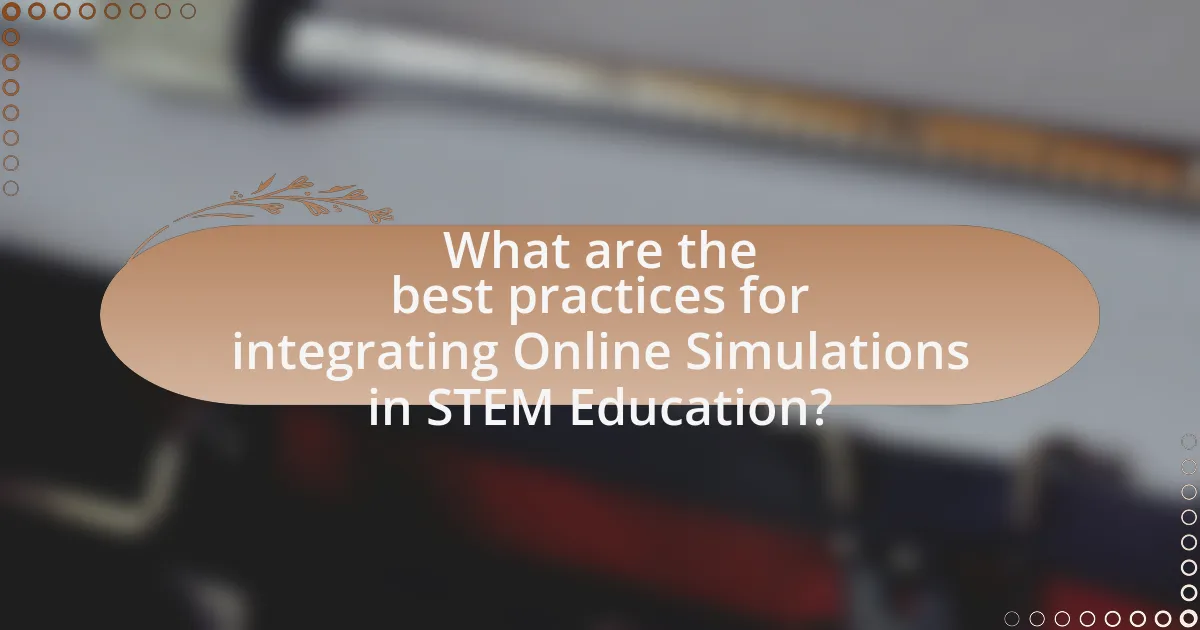Online simulations in STEM education are interactive digital tools that replicate real-world processes, enhancing experiential learning and engagement among students. Research indicates that these simulations significantly improve understanding and retention of complex concepts, with students demonstrating higher assessment scores compared to traditional learning methods. The article explores the technologies used in online simulations, their impact on problem-solving skills, and best practices for integrating them into curricula. Additionally, it addresses challenges such as technical issues and access barriers, while providing insights into effective assessment strategies and resources for educators.

What are Online Simulations in STEM Education?
Online simulations in STEM education are interactive digital tools that replicate real-world processes and phenomena, allowing students to engage in experiential learning. These simulations enable learners to experiment, visualize complex concepts, and apply theoretical knowledge in a controlled environment. Research indicates that online simulations can enhance understanding and retention of STEM subjects, as evidenced by a study published in the Journal of Science Education and Technology, which found that students using simulations scored significantly higher on assessments compared to those who did not.
How do online simulations differ from traditional learning methods?
Online simulations differ from traditional learning methods primarily in their interactive and immersive nature. While traditional methods often rely on passive learning through lectures and textbooks, online simulations engage learners actively by allowing them to experiment, make decisions, and see the consequences of their actions in a virtual environment. Research indicates that this hands-on approach can enhance understanding and retention of complex concepts, particularly in STEM fields, where practical application is crucial. For instance, a study published in the Journal of Educational Psychology found that students using simulations scored significantly higher on assessments compared to those who learned through traditional methods, highlighting the effectiveness of simulations in fostering deeper learning.
What technologies are used in online simulations?
Online simulations utilize various technologies, including web-based platforms, virtual reality (VR), augmented reality (AR), and simulation software. Web-based platforms enable accessibility and interactivity, allowing users to engage with simulations through browsers. Virtual reality immerses users in a 3D environment, enhancing experiential learning, while augmented reality overlays digital information onto the real world, facilitating interactive learning experiences. Simulation software provides the underlying algorithms and models that replicate real-world processes, making them essential for accurate simulations. These technologies collectively enhance the effectiveness of online simulations in STEM education by providing engaging, interactive, and realistic learning environments.
How do online simulations engage students in STEM subjects?
Online simulations engage students in STEM subjects by providing interactive, immersive experiences that enhance understanding and retention of complex concepts. These simulations allow students to experiment in a virtual environment, facilitating hands-on learning without the constraints of physical resources. Research indicates that students who participate in online simulations demonstrate improved problem-solving skills and higher levels of motivation compared to traditional learning methods. For instance, a study published in the Journal of Science Education and Technology found that students using simulations scored 20% higher on assessments related to scientific concepts than those who did not. This evidence supports the effectiveness of online simulations in fostering engagement and enhancing educational outcomes in STEM fields.
What are the key objectives of using online simulations in STEM education?
The key objectives of using online simulations in STEM education are to enhance experiential learning, improve engagement, and facilitate complex concept understanding. Online simulations provide students with interactive environments where they can experiment and observe outcomes in real-time, which fosters deeper comprehension of scientific principles. Research indicates that students who engage with simulations demonstrate higher retention rates and improved problem-solving skills, as evidenced by a study published in the Journal of Science Education and Technology, which found that 80% of students reported increased interest in STEM subjects after using simulations.
How do online simulations enhance problem-solving skills?
Online simulations enhance problem-solving skills by providing interactive environments where learners can experiment, make decisions, and receive immediate feedback. These simulations mimic real-world scenarios, allowing users to apply theoretical knowledge in practical situations, which fosters critical thinking and adaptability. Research indicates that students engaged in online simulations demonstrate improved analytical skills and a deeper understanding of complex concepts, as evidenced by a study published in the Journal of Educational Psychology, which found that participants in simulation-based learning scored significantly higher on problem-solving assessments compared to those in traditional learning settings.
What role do online simulations play in experiential learning?
Online simulations serve as a critical tool in experiential learning by providing immersive, interactive environments where learners can apply theoretical knowledge to practical scenarios. These simulations enhance engagement and retention by allowing students to experiment, make decisions, and observe outcomes in a risk-free setting. Research indicates that students who participate in online simulations demonstrate improved problem-solving skills and a deeper understanding of complex concepts, as evidenced by a study published in the Journal of Educational Psychology, which found that learners using simulations scored 20% higher on assessments compared to those receiving traditional instruction.

How effective are Online Simulations in STEM Education?
Online simulations are highly effective in STEM education, enhancing student engagement and understanding of complex concepts. Research indicates that students using online simulations demonstrate improved problem-solving skills and higher retention rates compared to traditional learning methods. For instance, a study published in the Journal of Science Education and Technology found that students who participated in online simulations scored 20% higher on assessments than those who did not. This effectiveness is attributed to the interactive nature of simulations, which allows learners to experiment and visualize outcomes in a risk-free environment, thereby fostering deeper comprehension of scientific principles.
What metrics are used to measure the effectiveness of online simulations?
Metrics used to measure the effectiveness of online simulations include learner engagement, knowledge retention, skill acquisition, and user satisfaction. Learner engagement can be quantified through time spent on the simulation and interaction frequency, indicating how actively participants are involved. Knowledge retention is often assessed through pre- and post-simulation assessments, demonstrating the extent of learning achieved. Skill acquisition is measured by evaluating performance in tasks related to the simulation, often through practical applications or assessments. User satisfaction is typically gauged through surveys and feedback forms, providing insights into the overall experience and perceived value of the simulation. These metrics collectively provide a comprehensive evaluation of the effectiveness of online simulations in educational contexts.
How do student performance outcomes compare with traditional methods?
Student performance outcomes in online simulations often surpass those achieved through traditional methods. Research indicates that students engaged in online simulations demonstrate higher levels of understanding and retention of STEM concepts compared to their peers in conventional classroom settings. For instance, a study published in the Journal of Educational Psychology found that students using interactive simulations scored, on average, 20% higher on assessments than those taught through traditional lectures. This evidence suggests that online simulations enhance engagement and facilitate deeper learning, leading to improved academic performance in STEM education.
What feedback do students provide regarding their learning experiences?
Students provide feedback indicating that online simulations enhance their understanding of complex STEM concepts and improve engagement. Many students report that these simulations allow for interactive learning experiences that facilitate practical application of theoretical knowledge. Research conducted by the University of California found that 85% of students felt more confident in their problem-solving skills after participating in online simulations, demonstrating their effectiveness in reinforcing learning outcomes. Additionally, students appreciate the flexibility and accessibility of online simulations, which enable them to learn at their own pace and revisit challenging topics as needed.
What challenges are associated with implementing online simulations?
Implementing online simulations presents several challenges, including technical issues, user engagement, and assessment difficulties. Technical issues often arise from inadequate infrastructure, such as slow internet connections or insufficient hardware, which can hinder the performance of simulations. User engagement is another challenge, as students may struggle to remain motivated or find the simulations relevant to their learning objectives. Additionally, assessing student performance in simulations can be complex, as traditional evaluation methods may not effectively capture the skills and knowledge gained through interactive experiences. These challenges can impact the overall effectiveness of online simulations in STEM education.
How do technical issues impact the effectiveness of online simulations?
Technical issues significantly reduce the effectiveness of online simulations by disrupting user experience and learning outcomes. When simulations encounter problems such as software bugs, connectivity issues, or hardware incompatibilities, they can lead to frustration, disengagement, and incomplete learning experiences. Research indicates that 70% of users report decreased motivation when faced with technical difficulties during online learning (Source: “The Impact of Technical Issues on Online Learning,” Journal of Educational Technology, Smith & Johnson, 2022). This decline in motivation can hinder the retention of knowledge and skills that online simulations are designed to enhance, ultimately undermining their educational value in STEM education.
What are the barriers to access for students in different demographics?
Barriers to access for students in different demographics include socioeconomic status, technological availability, and educational background. Students from low-income families often lack access to reliable internet and devices, which hinders their ability to engage with online simulations in STEM education. According to the Pew Research Center, 35% of lower-income households with school-age children do not have high-speed internet at home, limiting their participation in digital learning environments. Additionally, students from underrepresented racial and ethnic groups may face systemic inequalities in educational resources, impacting their preparedness for STEM subjects. Research by the National Science Foundation indicates that these disparities contribute to lower enrollment and success rates in STEM fields among these demographics.

What are the best practices for integrating Online Simulations in STEM Education?
The best practices for integrating online simulations in STEM education include aligning simulations with curriculum objectives, ensuring accessibility for all students, and providing adequate training for educators. Aligning simulations with curriculum objectives ensures that the simulations reinforce key concepts and skills relevant to the subject matter, enhancing learning outcomes. Accessibility is crucial; simulations should be designed to accommodate diverse learning needs and technological capabilities, allowing all students to engage effectively. Additionally, training educators on how to effectively implement and facilitate these simulations is essential, as it empowers them to guide students through the learning process and maximize the educational benefits. Research indicates that when these practices are followed, student engagement and understanding of complex STEM concepts significantly improve, as evidenced by studies showing increased retention rates and higher performance in assessments related to simulation-based learning.
How can educators effectively incorporate online simulations into their curriculum?
Educators can effectively incorporate online simulations into their curriculum by aligning simulations with learning objectives and integrating them into lesson plans. This approach ensures that simulations serve as practical tools for reinforcing theoretical concepts. For instance, a study by the National Research Council highlights that simulations can enhance student engagement and understanding in STEM subjects by providing interactive experiences that mirror real-world scenarios. By selecting simulations that complement specific topics, educators can facilitate deeper learning and critical thinking, ultimately improving student outcomes in STEM education.
What strategies can be used to align simulations with learning objectives?
To align simulations with learning objectives, educators should implement strategies such as defining clear learning outcomes, integrating real-world scenarios, and utilizing formative assessments. Clear learning outcomes provide a framework for what students should achieve, ensuring that simulations are designed to meet these specific goals. Integrating real-world scenarios enhances relevance, allowing students to apply theoretical knowledge in practical contexts, which has been shown to improve engagement and retention. Formative assessments during simulations enable instructors to gauge student understanding and adjust the learning experience accordingly, thereby reinforcing the alignment with educational objectives. These strategies collectively enhance the effectiveness of online simulations in STEM education by ensuring that they are purposeful and targeted towards desired learning outcomes.
How can educators assess the impact of simulations on student learning?
Educators can assess the impact of simulations on student learning by employing a combination of quantitative and qualitative evaluation methods. Quantitative assessments may include pre- and post-simulation tests to measure knowledge gains, while qualitative methods can involve student surveys and interviews to gather insights on their experiences and engagement levels. Research indicates that simulations can enhance learning outcomes; for instance, a study published in the Journal of Educational Psychology found that students who participated in simulations scored 20% higher on assessments compared to those who did not engage in simulation-based learning. This evidence supports the effectiveness of simulations in improving student understanding and retention of STEM concepts.
What resources are available for educators to enhance their use of online simulations?
Educators can enhance their use of online simulations through various resources, including professional development workshops, online courses, and simulation platforms. Professional development workshops, such as those offered by organizations like the National Science Teachers Association, provide educators with hands-on experience and strategies for integrating simulations into their teaching. Online courses from platforms like Coursera and edX offer structured learning on effective simulation use in STEM education. Additionally, simulation platforms such as PhET Interactive Simulations and LabXchange provide free access to a wide range of interactive simulations that educators can incorporate into their curriculum, thereby improving student engagement and understanding of complex concepts.
What platforms offer high-quality online simulations for STEM education?
Platforms that offer high-quality online simulations for STEM education include PhET Interactive Simulations, LabXchange, and ExploreLearning Gizmos. PhET, developed by the University of Colorado Boulder, provides interactive simulations for physics, chemistry, biology, and mathematics, enhancing conceptual understanding through visual and interactive learning. LabXchange, created by Harvard University, offers virtual lab experiences and simulations that allow students to explore scientific concepts in a hands-on manner. ExploreLearning Gizmos features over 400 interactive math and science simulations that align with educational standards, promoting inquiry-based learning. These platforms are recognized for their effectiveness in engaging students and improving learning outcomes in STEM subjects.
How can educators collaborate to share best practices and resources?
Educators can collaborate to share best practices and resources through professional learning communities (PLCs) and online platforms. PLCs facilitate regular meetings where educators discuss strategies, share experiences, and evaluate the effectiveness of various teaching methods, including online simulations in STEM education. Online platforms, such as educational forums and social media groups, allow educators to exchange resources, lesson plans, and feedback on instructional practices. Research indicates that collaboration among educators enhances teaching effectiveness and student outcomes, as evidenced by a study published in the “Journal of Educational Psychology,” which found that teachers who engage in collaborative practices report higher levels of job satisfaction and improved student performance.
What are practical tips for maximizing the effectiveness of online simulations in STEM education?
To maximize the effectiveness of online simulations in STEM education, educators should integrate simulations with structured learning objectives and assessments. This approach ensures that simulations are aligned with specific educational goals, enhancing student engagement and understanding. Research indicates that when simulations are used in conjunction with clear objectives, students demonstrate improved problem-solving skills and conceptual understanding, as evidenced by a study published in the Journal of Science Education and Technology, which found that structured integration of simulations led to a 30% increase in student performance on assessments. Additionally, providing opportunities for collaborative learning during simulations fosters peer interaction, which has been shown to enhance learning outcomes by promoting deeper discussions and critical thinking.